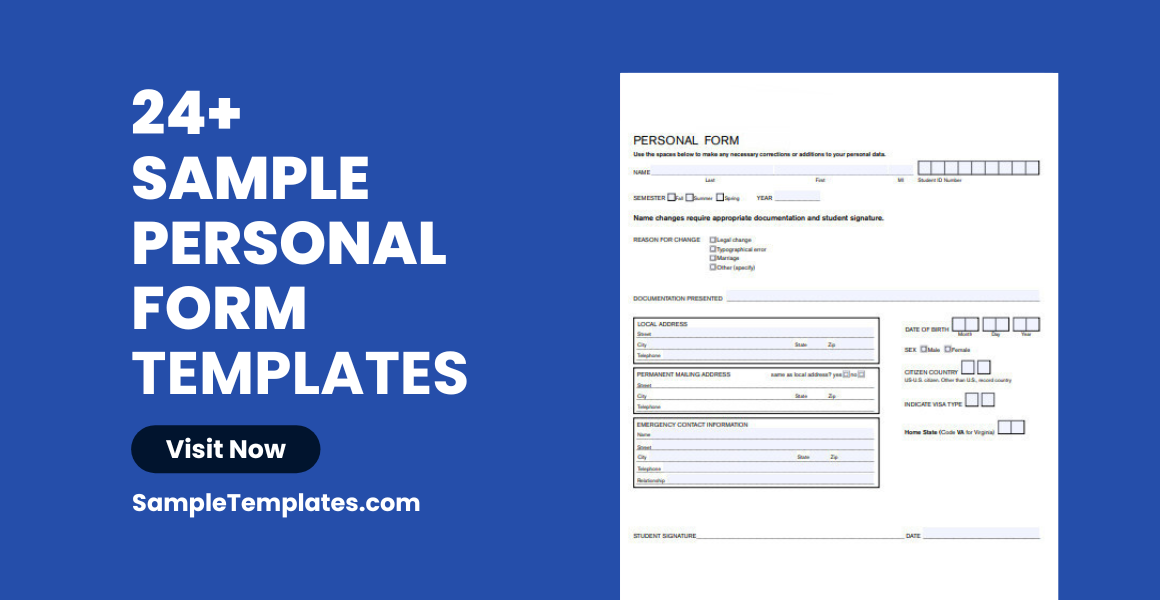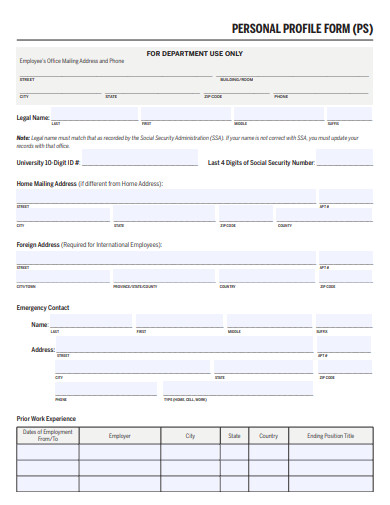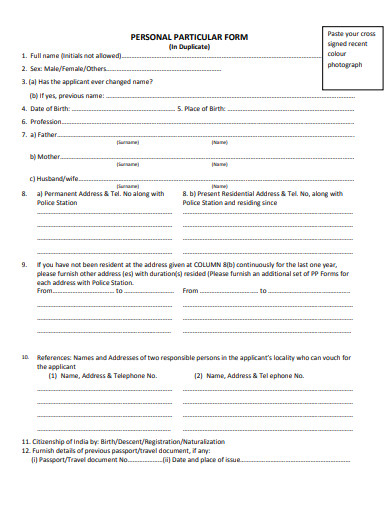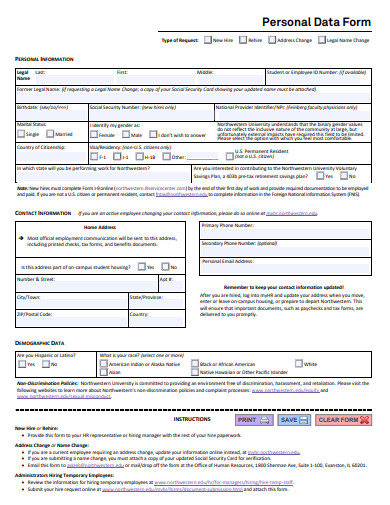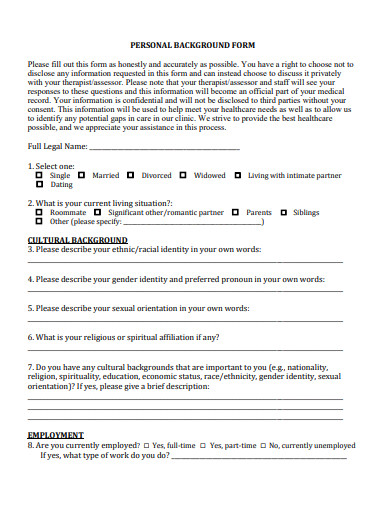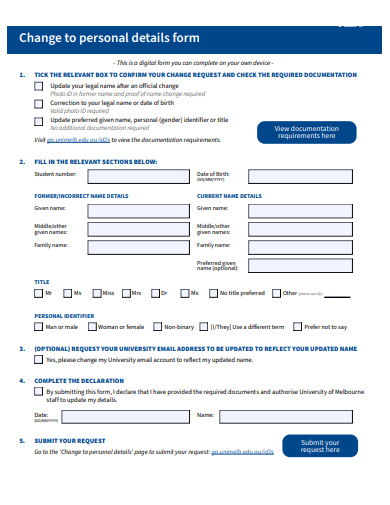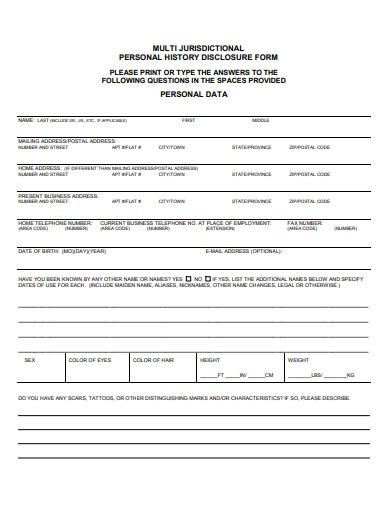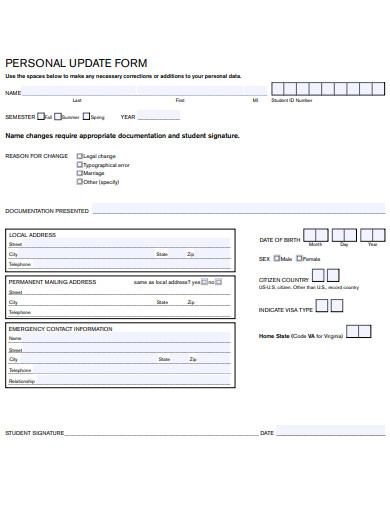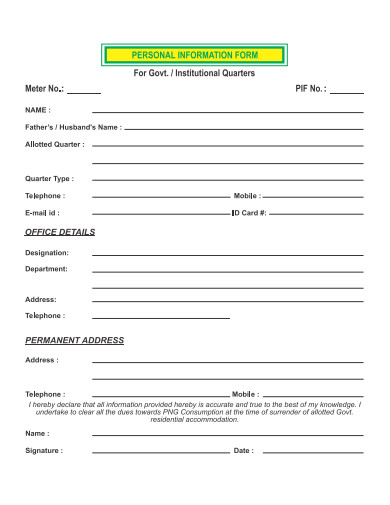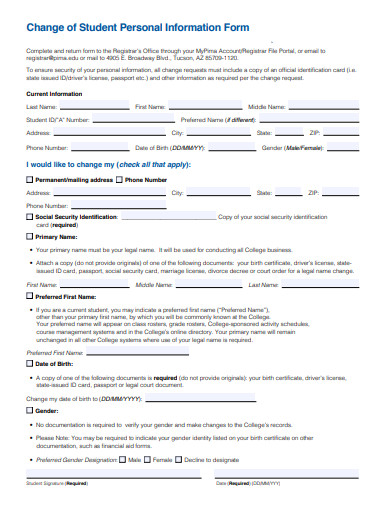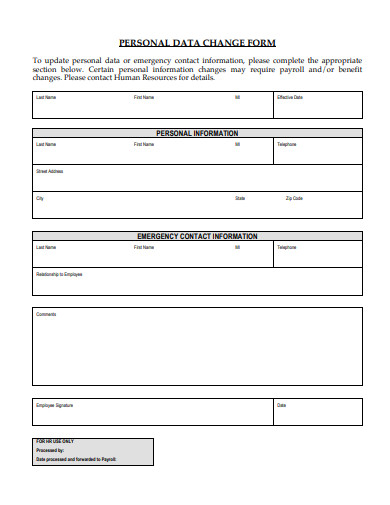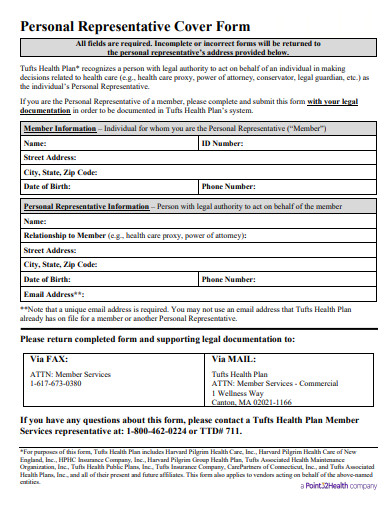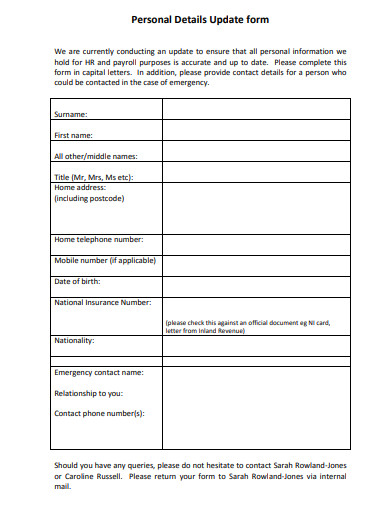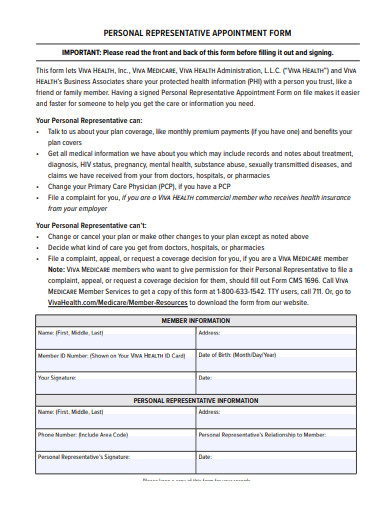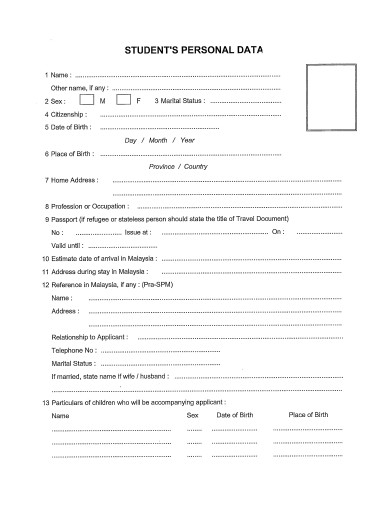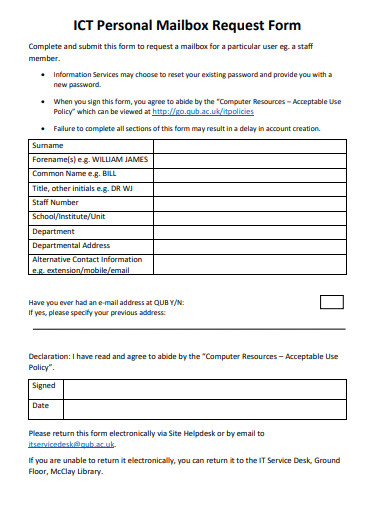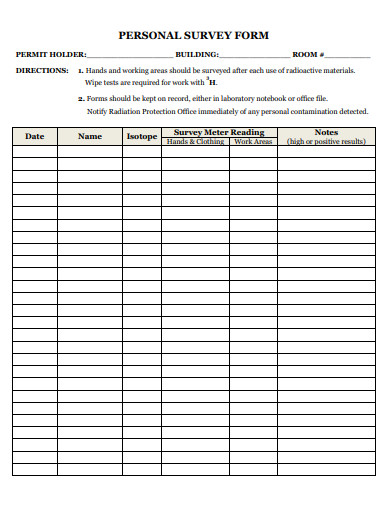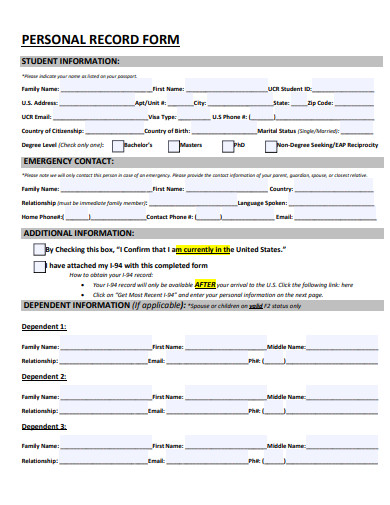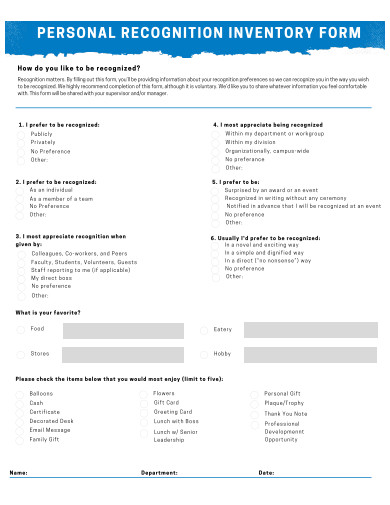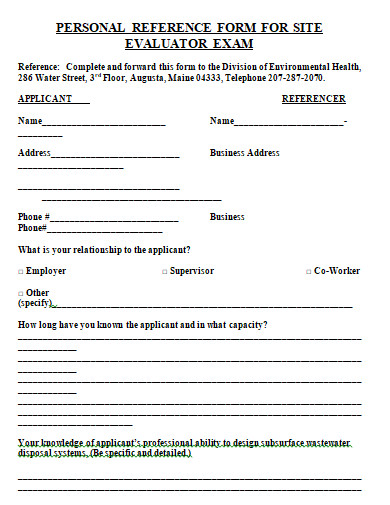In an interconnected world, the ‘Personal Form’ is a vital tool for capturing essential individual details. From organizations to digital platforms, these sample forms are integral to understand and cater to an individual’s needs. Seamlessly blending privacy with accessibility, a well-structured Personal Form ensures efficient data collection while respecting personal boundaries. Dive into our comprehensive exploration of the significance, design, and best practices surrounding Personal Forms in contemporary contexts.
24+ Personal Form Samples
1. Sample Personal Incident Report Form Template

2. Sample Employee Personal Details Form Template

3. Sample School Staff Personal Information Form Template

4. Sample Volunteer Personal Application Form Template
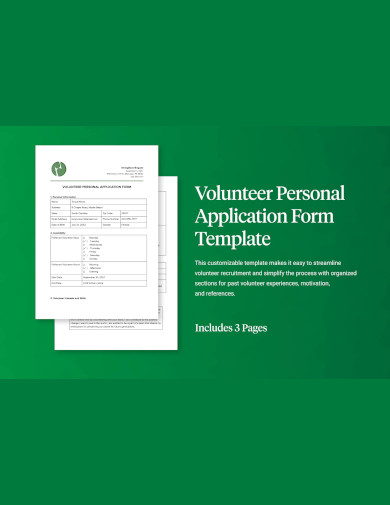
5. Sample Construction Personal Information Form Template
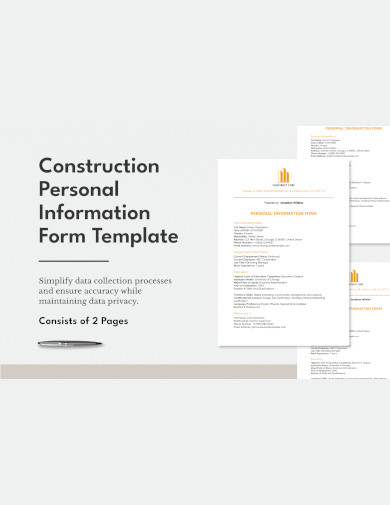
6. Sample Personal Profile Form Template
What is Personal Form?
A personal form is a tool used to gather specific information from an individual. These forms can vary widely in content and purpose, but at their core, they’re designed to capture data in a structured manner. From everyday online interactions to crucial official procedures, personal forms play a pivotal role in data collection and management.
Understanding Personal Forms
In the age of digital communication and data collection, personal forms have become increasingly crucial. Whether we’re signing up for an online service, providing a sample feedback, or filling out an official document, these forms help organize and process our information. But what exactly is a personal form? Let’s dive deep.
Origins and Evolution
Personal forms have been around for centuries. Historically, they were physical sample paper documents that people filled out by hand, like a census form or a job application. With the advent of computers and the internet, these forms have largely migrated online, but their purpose remains largely unchanged: to collect and record individual information.
Diverse Applications of Personal Forms
Online Activities
- Registration and Sign-ups: Websites and apps often require users to fill out a form when creating an account. This helps platforms collect necessary details such as name, email, and preferences.
- Purchases and Orders: E-commerce sites utilize forms to gather shipping and payment details from customers.
Institutional Procedures
- Admissions and Applications: Universities, colleges, and even some schools use forms to gather information from prospective students, assessing their fit and eligibility for sample programs.
- Employment: Job applications, often the first step in the hiring process, are another instance of personal forms where candidates provide details about their qualifications, experience, and references.
Official and Governmental Processes
- Identification and Documentation: Forms are used to apply for documents like passports, driving licenses, and voter IDs.
- Tax and Financial Procedures: Tax filing, bank account opening, and loan applications all require forms to be filled out with personal and financial details.
Medical and Healthcare
- Patient Details: Clinics and hospitals use personal forms to record patient histories, allergies, and other essential medical information.
- Consent and Agreements: Before medical procedures, patients might need to fill out and sign consent forms.
Types of Personal Forms
There are numerous personal forms that individuals might encounter in everyday life. Here are some of the most common ones:
- Registration Forms: Used for signing up to analysis websites, apps, events, or services.
- Feedback and Survey Forms: Allow users to give feedback or answer specific questions.
- Order and Purchase Forms: Used in e-commerce for product purchase.
- Application Forms: Used for job applications, loan requests, college admissions, and more.
Designing Effective Personal Forms
The design of a personal form is as crucial as its function. A well-designed form encourages completion, reduces errors, and ensures that the data collected is accurate.
- Clarity and Simplicity: It should be immediately clear to users what information is required and why. Avoid jargon and complex language.
- Logical Flow: Questions should be organized in a logical order, starting with general questions and moving to more specific ones.
- Validation: Implement real-time validation to guide users in providing the correct information. For example, indicating a wrongly formatted email address.
- Progress Indicators: For longer forms, showing a progress bar can motivate users to complete the form. You can also see more templates like Employee Forms Samples.
Security and Privacy Concerns
In the digital era, the security of personal forms has become paramount. Users are entrusting their personal and sometimes sensitive information.
- Data Encryption: Ensure that data is encrypted during transmission and when stored.
- Privacy Policies: Always have a clear and accessible privacy policy that details how the data will be used and stored.
- Regular Updates: Technology and cyber threats are constantly evolving. Regularly updating and patching software helps protect against vulnerabilities.
The Future of Personal Forms
As technology continues to advance, we can expect personal forms to evolve as well. Here’s what might be on the horizon:
- Voice-activated Forms: With the rise of voice assistants, we might soon be filling out forms using our voices rather than typing.
- AI-Powered Forms: AI could predict and auto-fill certain fields based on user behavior and past inputs.
- Virtual Reality and Augmented Reality Forms: As VR and AR technologies become more commonplace, we might see forms that can be filled out in a 3D space.
Who creates a Personal Form?
Personal forms, as ubiquitous as they might seem, originate from various entities and for varied reasons. The creators of these forms have specific sample objectives, whether it’s data collection, user registration, or facilitating transactions. Let’s delve into the diverse creators of personal forms and understand their motivations.
Businesses and Corporations
- User Registration and Account Creation: Many online platforms, from e-commerce websites to social media networks, require users to fill out a registration form. This allows businesses to create user accounts, understand their demographics, and provide personalized services.
- Feedback and Surveys: Businesses often want to gauge customer satisfaction or gather insights about a product or service. Thus, they might design survey forms that ask users for their feedback.
- Ordering and Purchasing: E-commerce sites and online marketplaces require forms to gather shipping information, payment details, and product preferences.
Educational Institutions
- Admission Forms: Schools, colleges, and universities use personal forms to gather information from prospective students. These forms often collect academic, extracurricular, and personal information to aid the admission process.
- Feedback Forms: Institutions might also use forms to gather feedback on courses, instructors, or facilities.
Government Entities
- Census and Surveys: Governments around the world conduct periodic censuses to gather demographic, housing, and economic information about their populations. This data helps in sample planning and policy-making.
- Application Forms: Governments also provide various services to their citizens, from issuing passports to granting licenses. Each of these services usually requires a form to gather the necessary information.
Healthcare Providers
- Patient Intake Forms: When visiting a doctor or a medical facility for the first time, patients often need to fill out an intake form that collects medical history, current complaints, and other relevant data.
- Consent Forms: Before undergoing a specific medical procedure, patients might be required to sign a consent form, indicating they understand the risks and benefits.
Non-Profit Organizations
- Donation Forms: NGOs and charitable organizations often create forms to facilitate donations, capturing necessary details like donor information, payment preferences, and the cause they wish to support.
- Volunteer Registration: NGOs also need to gather information about volunteers, their skills, availability, and areas of interest.
Individuals
While larger entities typically create most personal forms, individuals can also craft them for personal use or small-scale activities.
- Event Invitations: Someone hosting a personal event might create a form to gather RSVPs, dietary preferences, or song requests.
- Personal Surveys: An individual might be curious about friends’ movie preferences or opinions on a personal project. They can design a form to collect this data.
7. Sample Personal Particular Form Template
8. Sample Personal Data Form Template
9. Sample Personal Background Form Template
10. Sample Change to Personal Details Form Template
11. Sample Personal History Disclosure Form Template
12. Sample Personal Update Form Template
13. Sample Personal Information Form Template
14. Sample Change of Student Personal Information Form Template
15. Sample Personal Data Change Form Template
16. Sample Personal Account Application Form Template
17. Sample Personal Representative Cover Form Template
18. Sample Personal Details Update form Template
19. Sample Personal Representative Appointment Form Template
20. Sample Students Personal Data Form Template
21. Sample Personal Mailbox Request Form Template
22. Sample Personal Survey Form Template
23. Sample Personal Record Form Template
24. Sample Personal Recognition Inventory Form Template
25. Sample Personal Reference Form Template
How do you Create an Personal Form?
Creating a personal form can be essential for a variety of reasons—be it for sample event registrations, feedback, or even personal surveys. A well-structured form can help gather precise and useful information from the respondents. Here’s a straightforward guide to creating a personal form in five steps:
Step1: Determine the Purpose Before diving into form creation, clarity about its purpose is essential. Are you looking to gather feedback, collect RSVPs for an event, or maybe gather information for personal research? The purpose will influence the questions you ask, the format of the form, and the platform you choose to create it. Jot down the main objectives of the form, as this will be your guiding beacon in the subsequent steps.
Step2: Choose a Platform Depending on your needs and tech-savviness, there are numerous platforms to create forms. Platforms like Google Forms, Typeform, and SurveyMonkey are user-friendly and suitable for most general purposes. For more complex forms or if you’re integrating it into a sample website, tools like JotForm or Wufoo might be more appropriate. Choose a platform that aligns with your needs, and ensure it’s mobile-responsive, as many respondents might access the form via mobile devices.
Step3: Design and Structure With your purpose clear and platform chosen, begin designing the form. Start with an engaging title and a brief description to let respondents know what the form is about. Structure is crucial:
- Sequential Flow: Ensure questions follow a logical sequence.
- Question Types: Decide between open-ended questions, multiple choice, scales, or checkboxes. Use a mix to keep the respondent engaged and provide you with varied data.
- Required Fields: Mark essential questions as ‘required’ to prevent respondents from skipping them.
Step4: Test and Refine Before making the form public, test it. Share it among a small group of friends or colleagues to gather feedback. Ensure the questions are clear and the form works seamlessly on both desktop and mobile. Based on the feedback, refine and tweak the form to improve clarity and user experience. It’s better to identify and fix issues at this stage rather than realizing them after collecting a lot of responses.
Step5: Distribute and Collect Data Now that your form is ready, distribute it to your intended audience. Share the link via email, social media, or embed it on your website, depending on where your target respondents are. Once the responses start coming in, most platforms will allow you to view and analyze the data within their interface. Additionally, consider exporting the data to a spreadsheet for more in-depth sample analysis if necessary.
In Conclusion, personal forms are while a seemingly simple concept, play a vital role in information gathering in today’s digital age. Their design, function, and security are essential for a smooth user experience and the protection of personal data. As technology pushes the boundaries of what’s possible, these forms will continue to adapt, offering exciting possibilities for the future. You can also see more templates like Statement Forms.
Related Posts
Parent Consent Form Samples & Templates
Sample Release of Liability Forms
Sample Training Feedback Forms
Sample Sworn Affidavit Forms
Agreement Form Samples & Templates
Vehicle Inspection Forms Samples & Templates
Sample Employee Advance Forms
Sample Child Travel Consent Forms
Sample Testimonial Request Forms
Sample Employee Details Forms
Sample Divorce Forms
Sample Attestation Forms
Employee Performance Appraisal Form Templates
FREE 9+ Sample Presentation Evaluation Forms in MS Word
FREE 10+ School Admission Form Samples & Templates in MS Word | PDF
